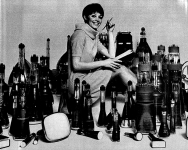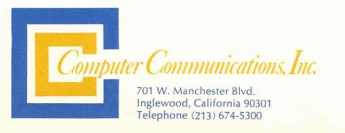voidstar78
Veteran Member
I found came across the following in a 1968 Datamation magazine issue, which has two great articles:
Low-Cost Remote CRT Terminals (pg22) [ low cost being under $20,000; the end of the article mentions some vector-CRTs but none of them being under this cost threshold ]
"Why do users want more expensive terminals instead of typewriter or Teletype terminals, which are very commonplace today? One prime advantage of crt terminals is the fast reception of messages at maximum telephone line rates -120 to 300 characters per second versus 10 to 20 characters per second for Teletype or typewriters. This allows the user to inspect and assimilate messages at a much faster pacy, thus permitting the operator to spend less time staring at the messages. Another major advantage of crt terminals is the ability to selectively delete and change characters or words in desired records or files. Quietness is also an attractive characteristic. The major disadvantages are higher co~t and difficulty in obtaining a hard copy capability. Several manufacturers are offering as options various' equipment approaches 'to meet this latter need."
[ interesting to me that there was no apparent foresight that once these became cheap and everyone had a CRT, then the issue of needing hard-copy becomes moot ]
Software for Terminal-Oriented Systems (pg30)
"There are also hardware developments of a more special nature, seeking to fulfill the growing need for remote access to data processing systems. These devices seek to match . more specific requirements (e.g., graphical input), meet the need for portability and, most of all, be more economical. Of particular 'interest is the growing terminal technology that will augment the potentially cheapest and most ubiquitous of all terminals, the Touch-Tone telephone. Examples of such recent developments are shown in Figs. 1 through 5. All of this spells the beginning of the on-line revolution. During the first 15 years of the computer age, data processing provided impersonal services to users. Thus, payrolls, invoices, and fimi.ncial reports may have been processed by computers, but man's activities typically were not directly affected or modified. The present on-line trend, however, .directly affects the manner in which man's everyday activities are conducted. Thus, the presence of computing power, through appropriate man/machine interfaces, will surely reach into every business office, as well as classroom, and even into the home itself."
I assume this photo is just a concept prop and not anything functional (since nothing is on the screen).
Does anyone recognize the "[ C ]" logo? (or maybe it's just a generic placeholder, perhaps it even means "concept" ?).
But it's neat how it basically looks like a TRS-80 with a lightpen attachment

Low-Cost Remote CRT Terminals (pg22) [ low cost being under $20,000; the end of the article mentions some vector-CRTs but none of them being under this cost threshold ]
"Why do users want more expensive terminals instead of typewriter or Teletype terminals, which are very commonplace today? One prime advantage of crt terminals is the fast reception of messages at maximum telephone line rates -120 to 300 characters per second versus 10 to 20 characters per second for Teletype or typewriters. This allows the user to inspect and assimilate messages at a much faster pacy, thus permitting the operator to spend less time staring at the messages. Another major advantage of crt terminals is the ability to selectively delete and change characters or words in desired records or files. Quietness is also an attractive characteristic. The major disadvantages are higher co~t and difficulty in obtaining a hard copy capability. Several manufacturers are offering as options various' equipment approaches 'to meet this latter need."
[ interesting to me that there was no apparent foresight that once these became cheap and everyone had a CRT, then the issue of needing hard-copy becomes moot ]
Software for Terminal-Oriented Systems (pg30)
"There are also hardware developments of a more special nature, seeking to fulfill the growing need for remote access to data processing systems. These devices seek to match . more specific requirements (e.g., graphical input), meet the need for portability and, most of all, be more economical. Of particular 'interest is the growing terminal technology that will augment the potentially cheapest and most ubiquitous of all terminals, the Touch-Tone telephone. Examples of such recent developments are shown in Figs. 1 through 5. All of this spells the beginning of the on-line revolution. During the first 15 years of the computer age, data processing provided impersonal services to users. Thus, payrolls, invoices, and fimi.ncial reports may have been processed by computers, but man's activities typically were not directly affected or modified. The present on-line trend, however, .directly affects the manner in which man's everyday activities are conducted. Thus, the presence of computing power, through appropriate man/machine interfaces, will surely reach into every business office, as well as classroom, and even into the home itself."
I assume this photo is just a concept prop and not anything functional (since nothing is on the screen).
Does anyone recognize the "[ C ]" logo? (or maybe it's just a generic placeholder, perhaps it even means "concept" ?).
But it's neat how it basically looks like a TRS-80 with a lightpen attachment

Last edited:


